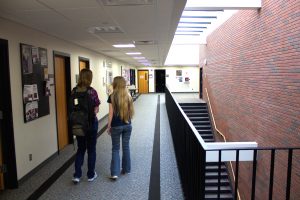By Angelina Labonne
Managing Editor
Angelina.labonne5022@mb.rctc.edu

Students walk through East Hall, where RCTC officials have been conducting mold remediation. (Echo Photo by Seth Boyum)
One wet summer season, water broke through the decrepit halls of our beloved Rochester campus and brought about a plague of fungus that would infect every student, teacher, or innocent bystander who dared step foot in our East Hall. Mold crept into every inch of the floors, ceilings, and air ducts. The college would never be the same again, and the fate of everyone infected still remains a mystery.
The above paragraph depicts what many readers are waiting to hear, a big juicy story revealing all the lies and coverups that took place here at RCTC to make sure a mold problem was kept a secret. Many rumors have been run across campus about this event, there is mold in the air duct spreading it all over campus, some would say, or they pulled WSU students and faculty but don’t care about RCTC students many accused.
Interviewing Nate Stoltman, RCTC Director of Communications and College Relations, with many speculations in mind, revealed some points worth sharing with the faculty and students at RCTC, especially those who are immediately concerned with going to class every day in East Hall.
First, the mold that was found was in a secluded area rather than spread throughout the school. Second, the mold was taken care of as soon as possible and as thorough, as possible. Lastly, efforts are still being made to make sure the health and well-being of all inhabitants of RCTC’s campus are protected.
It is true that last summer was a wet summer, and all the rain did in fact cause some issues with water infiltration in East Hall. All those in attendance at RCTC understand that East Hall is an older building, and on Nov. 11 it was discovered that the landscaping outside East Hall had risen above the water proofing material that was put on the side of the brick building. This lack of protection on East Hall caused the water to infiltrate the floor of the building (in one isolated area), which then promoted the fungal growth. In November, the reason for the water filtration was discovered. However, the process to clean up and keep everyone safe began in July.
On July 25, the campus administration decided to contract with the Institute for Environmental Assessment for indoor air quality. RCTC administrators wanted to know what type of mold they were dealing with and exactly how much of it was in the air. No mold was found in any office except one, but RCTC administrators decided to move the affected WSU facility on the first and second floor as a precaution. It is important to note that the fungal growth did not reach the second floor, or much of the first floor for that matter. However, the administration thought it better to be safe than sorry and moved everyone anyway.
So, where was the mold actually found then? Stoltman explained that the report indicated high levels of mold in EA129, but what is challenging though is “high” is not a health assessment because OSHA does not have a standard for what is a common or “safe” amount of mold in areas. Using words such as “high levels of mold” simply means that compared to what is normally found in an office space, this office had higher levels.
After realizing they did in fact have a problem, RCTC was instructed to clean all spaces using vacuums equipped with HEPA filters and wipe down the area thoroughly. Instead, the school decided to pull the carpet out of the infected office in addition to cleaning and vacuuming the first and second floors. Between the dates of Oct. 7 and Nov. 7 the first and second floors were vacuumed, cleaned out, and per Stanley Consultant’s recommendation, underwent some HVAC work as well.
The HVAC, or heating ventilation and air conditioning system, was to be replaced with a new chiller plant in the upcoming months. However, the failure of the bonding bill to pass the Minnesota Legislature earlier this year has put a halt on that and other projects desired here at RCTC. Instead of a full-on replacement, RCTC was faced with additional maintenance to prolong the life of the system.
The question now is, if there was no mold found in the air vents then why were some of the components cleaned or replaced?
“There was no mold in the HVAC system. Upon inspection, it was found that some components were not functioning properly, thus leading to the musty odors ÷ those issues have either been addressed or are in the process of being addressed with our contractor,” Stoltman said.
Before the new semester begins, Stoltman suggested that most, if not all, necessary measures will be completed to ensure that faculty can move back into their offices and the issue can be put to rest. The first-floor office moves, however, will be permanent, but it is simply because RCTC would like to have all the university offices in one place.
RCTC will have another indoor air quality assessment performed the beginning of spring semester to solidify the fact that no more levels of mold are found, and waterproofing on the side of the building will be brought up to standard. No work on the classrooms was deemed necessary because the mold was found only in one office, EA 129, and never touched any of the surrounding classrooms. With a new Legislature convening in January, RCTC may also obtain funding necessary to begin work on its many desired renovations to create a more updated campus to prevent future occurrences of such issues.
It is important to remember in situations like this that without facts, things like mold can seem scary. The view from inside EA 129 shows an office suite that had been left in a hurry. Pictures still hang on the wall, and personal items lie scattered about. The faculty who left the office space were also scared, and that is OK. What is not seen or smelled, however, is a musty, moldy smell, any signs of mold, or any surface left unclean.
The fear of the situation causes many to have doubts about what the administration and faculty are saying. It makes students want to believe that they are hiding something, but it is important to do two things as a campus Û trust our leaders and help in future efforts of safety. Reporting something that seems broken or (though hopefully not) even mold ridden at RCTC is the first step. Getting to a problem as soon as possible is a huge advantage in solving it.
“Their safety and well-being is top priority,” Stoltman said of the student body. “When this was brought to the college’s attention, we addressed it immediately, but we can’t address problems we don’t know about. Maintenance requests are now online, and the new system will track entries, what the issue was and how long it took to get fixed. Administration took the appropriate if not beyond appropriate actions and will constantly monitor the situation by doing a couple tests every year. But if you see a problem, you must report it.”
